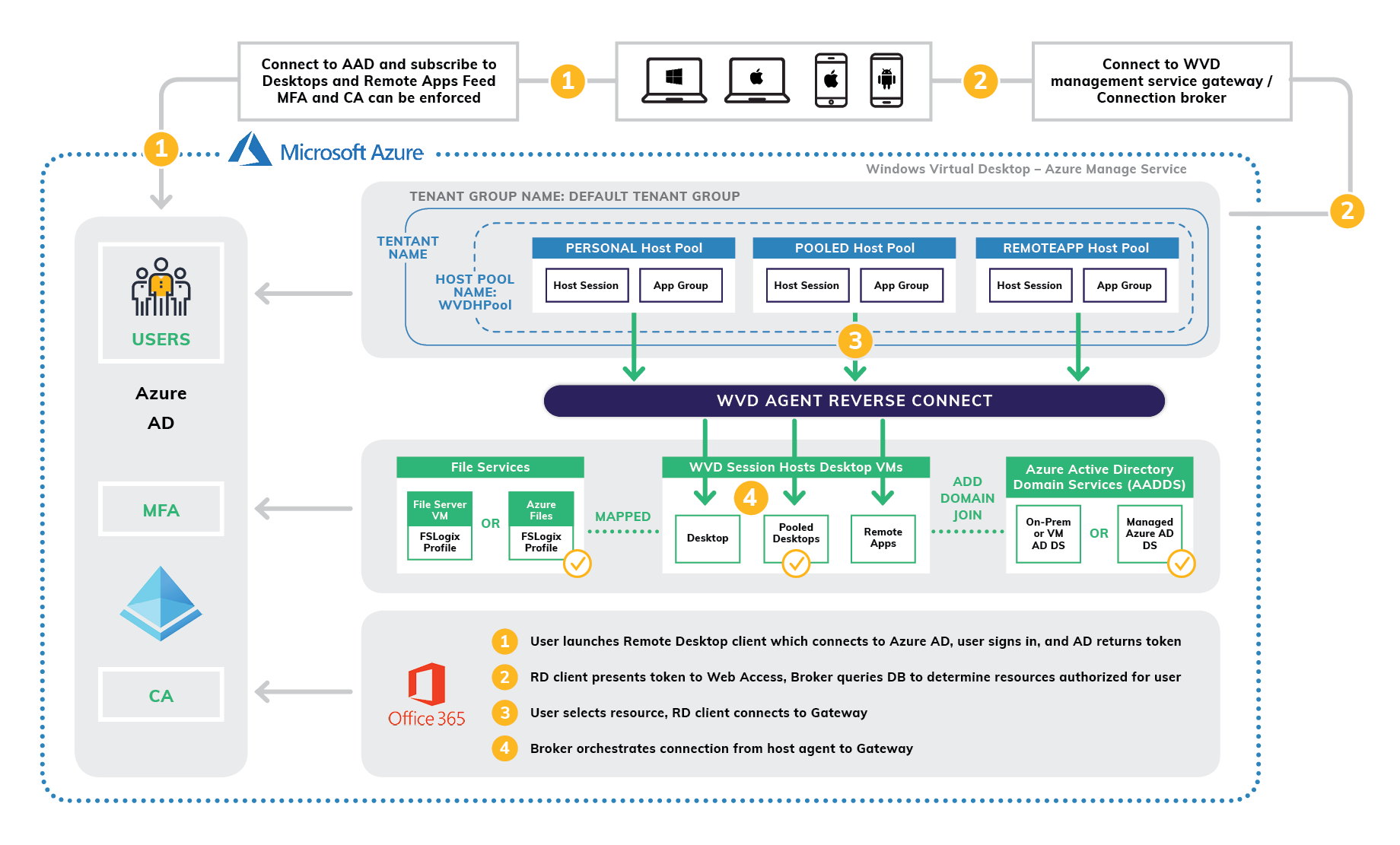Windows Virtual Desktop is the perfect tool for facilitating remote work. It allows for easy remote access whenever you need it.
Windows Virtual Desktop (WVD) is a desktop as a service (DaaS) offering that provides remote access to modern desktop applications from any device, anywhere, and at any time.
This fact makes it a digital workplace transformation tool perfect for companies who offer remote work options to employees, as it allows them to work safely from home with the same desktop experience they have in the office, and without multiple logins to various apps.
However, that is just the beginning.
In this blog post — the first of a series on WVD — we’ll explain why the WVD and remote workplace environment will grow exponentially in the coming years, and we’ll explore WVD’s capabilities and benefits. In future posts, we’ll show how you can safely take advantage of this new technology.
Why WVD — and Why Now?
High-performing remote teams are the secret sauce for many of today’s successful organizations. Companies accomplish more than 60 percent of the work they do today through some sort of remote collaboration tool. In 2022, the DaaS market was valued at approximately $4.9 billion, and was expected to reach $6.2 billion in 2023 and $18.7 billion by 2032, according to a recent market research study.
Beyond disruptions like the COVID-19 pandemic, WVD has multiple use cases for all organizations, regardless of size or industry. WVD can help you:
- Build a temporary workforce: Scale up or down quickly to accommodate temporary workers and contractors needed for tax season, seasonal hiring or other short-term needs.
- Expand your workforce: Instantly provision desktops in new territories or even countries without the time and complexity of setting up local IT resources.
- Run a business 24/7: Keep your business always-on with modern tools for collaboration, productivity and communications.
- Merge and acquire for growth: Transition securely to new organizational structures by giving everyone equal access to shared company resources.
- Control IT expenses: Only use what you need with cloud-based tools that don’t require unnecessary hardware or software.
Fortunately, if you are a Microsoft shop, you probably already have WVD included in your existing licenses. It allows you to only pay for compute, storage, and network consumption, leaving room to enjoy its many benefits at a price that’s lower than you might think.
WVD’s Benefits
While all DaaS tools have multiple benefits, WVD offers a broad range of advantages. Let’s break them down into six categories: quick and cost-effective deployments, simplicity, managed services, high performance, security and compliance.
Quick and Cost-Effective Deployments
- Deliver apps and desktops from the cloud, rather than a data center. Only pay for what you use.
- Simplify infrastructure changes and optimize business ROI, whether onboarding employees or preparing for a merger or acquisition.
- Enable online services with Windows 10’s new Edge Browser, which supports modern web standards such as improved HTML5 and CSS support and frequent updates, allowing for rapid application development across your enterprise.
Simplicity
- Use the entire O365 workload, including Microsoft Teams, online and with no VPN or multiple log-ons.
- Access work from any HTML5-capable browser or mobile device, including iOS, Android, Chromebook, laptop, desktop, or thin client.
- Replace your older Relational Database System with WVD to gain fast logon speeds and a more familiar, Windows-like look and feel.
Managed Services
- Provide desktops to any remote or temporary employees in days and easily close them down when not in use.
- Centralize and simplify application delivery with a single interface, freeing the IT department to work on more critical tasks that add value.
High Performance
- Deliver a great, high-definition user experience no matter where your team gets their work – in office, at home, or on-the-go.
- Render resource-intensive apps and demanding graphics alongside a simple task worker desktop, giving users the right desktop for the right job, all from a single solution and a single logon.
Security
- Ensure business continuity during weather or other events by scaling desktop on-demand up or down, without additional capital expense.
- Keep personal and corporate data separate through WVD and Windows 10’s Enterprise Data Protection (EDP) feature.
Compliance
- Move closer to GDPR privacy regulations with secure, cloud-based data storage.
- Run specialized workloads, including those requiring higher security and compliance measures.
A Look Under the Hood — WVD’s Architecture
WVD is a managed desktop and application virtualization service hosted on Microsoft Azure. It offers users a multi-session Windows 10 and Office 365 ProPlus environment that allows companies to easily deploy, integrate and manage cloud services and applications, such as Office 365 Single-Sign-On, One Drive Synchronization, and Backups, Microsoft Azure Active Directory Join, and Microsoft Intune for Mobile Device Management (MDM).
Here’s a look at WVD’s architecture:
Conclusion: The Future Is Here!
Think about all the things you can already do through a browser — use social media, watch any television or streaming channel, learn how to change a tire through YouTube. Why should work be any different? With tools like WVD, it doesn’t have to be.
We work every day with Digital Workplace Transformation tools, and we have strong strategic partnerships with all major workplace and IT infrastructure vendors to integrate the best solutions into your workplace.
Watch for our future posts about WVD, where we’ll be looking at topics like licensing, sizing, location and latency. We’ll also take a deep dive into add-ons such as FSLogix Profile Management, WVD Identity Management through Active Directory and Azure AD, App Assure, and App attach.


